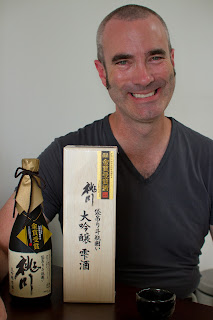Short video of working in the soil can be found on YouTube: http://youtu.be/Sy-VGIRZDBk
I was told to bring boots, but to my dismay, the Sports Authority sporting goods store in Aomori had absolutely no size 11 boots/shoes/Crocs/flipflops -- zilch! So I did not come prepared, which was okay, but I had to do the work in my stocking feet!
Gohyakumangoku!
What I can tell you about the rice is less significant than what I can tell you about the community that came together to harvest the rice, and the hospitality of the family who will brew sake from this rice. But I am a geek, and it's important to note that the rice is Gohyakumangoku variety. The most recent statistics I could find indicate that it is the second most popular rice, behind only Yamadanishiki, and accounted for 29.5% of the sake rice harvested in 2005. This famous rice is originally from Niigata, but is grown in Tochigi prefecture and elsewhere (Tochigi is adjacent to Niigata) and was officially designated in 1957. Resilient to cold, this sake rice (aka "sakamai") is often grown in areas not historically suitable for rice production. Because of the kernel's small size, this rice is usually milled to only to 50%, but because of its fruity aroma, this sakamai is highly prized for making ginjo and daiginjo sakes.
Community Effort
The day started at Shimazaki Shuzo itself where were were given instructions and also lead through some stretching exercises. It's worth noting there were dozens of volunteers present -- close to 100 -- and this includes entire families with small children working with sickles and tromping through the muddy rice fields doing the work alongside mom and dad.
Hospitality
When the work was done -- everyone was dog tired. We were grateful to get the harvest done the day before a typhoon was to arrive and even more grateful to be entertained back at the kura. There were new friendships forged over sake, a most delicious meal, and even live music at the very end of the evening.
I was there for most of the day, and very much appreciated Melinda's company as well as her friend Masumi. But when I got home, I had no trouble falling asleep!



























.JPG)
.JPG)
.JPG)






















.JPG)
.JPG)